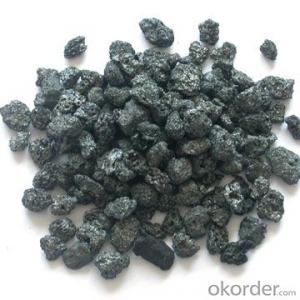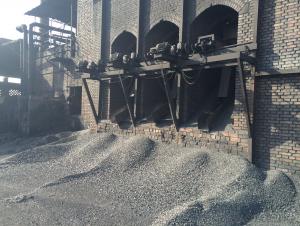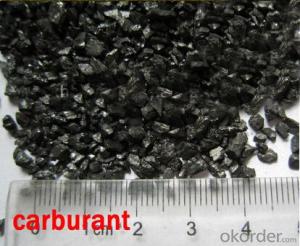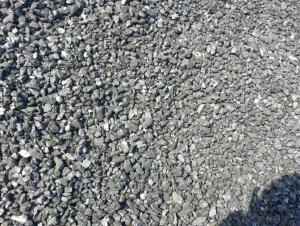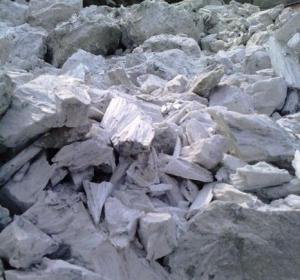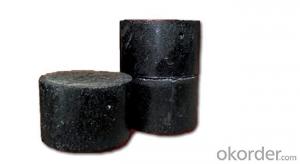Calcined Petroleum Coke as Injection Coke for Foundry Use
- Loading Port:
- Tianjin
- Payment Terms:
- TT OR LC
- Min Order Qty:
- 20.4
- Supply Capability:
- 1014 m.t./month
OKorder Service Pledge
OKorder Financial Service
You Might Also Like
Intrduction
Carbon additive to ningxia production of anthracite as raw material, after washing, crushing, high temperature calcination, filter, etc. Craft refined and become.This is after the anthracite calcination generated high carbon content and low volatile component of the new product, is an ideal raw material to make steel.
Calcined Petroleum Coke comes from delayed coke which extracted from oil refinery. Although Calcined Petroleum Coke contains a little bit higher level of sulfur and nitrogen than pitch coke, the price advantage still makes it widely used during steel-making and founding as a kind of carbon additive/carburant.
Features
In the smelting process for reducing agent. Performance: replace the traditional oil carbon additive, decrease the cost of steelmaking. Features: low ash. low sulfur,low phosphorus, high calorific value. High ratio resistance,high mechanical strength,high chemistry activity. It is mainly used for metallurgy reductant inoculants, casting, refractory materials, machinery, electronics and other fields.Good quality
1) high absorption rate, it can be absorbed up to 90%.
2) absorbed more quickly than other carbon additive; no residue remains in furnace.
3) low Sulfur, the lowest can reach below 0.20%; low nitrogen, normally below 200ppm (0.02%)
Specifications
CPC | |||
F.C.% | 98.5MIN | 98.5MIN | 98MIN |
ASH % | 0.8MAX | 0.8MAX | 1MAX |
V.M.% | 0.7 MAX | 0.7 MAX | 1 MAX |
SULFUR % | 0. 5MAX | 0. 7MAX | 1MAX |
MOISTURE % | 0.5MAX | 0.5MAX | 1MAX |
Pictures


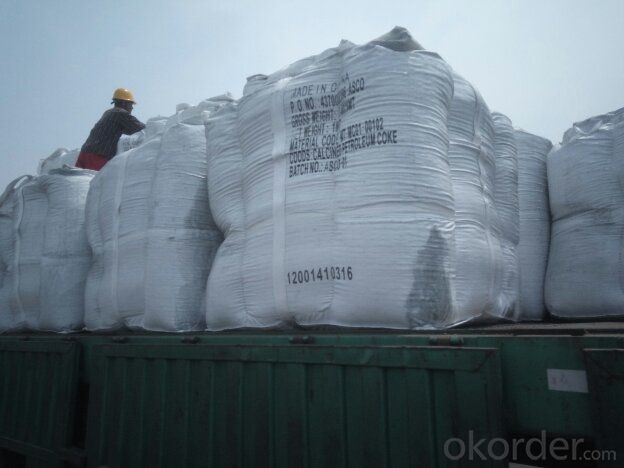

FAQ:
(1)CPC could be as fuel
Petroleum coke is a material relatively low in cost and high in heat value and carbon content with good chemical stability, making it an efficient and costeffective fuel for producing metal, brick and related products.
(2)CPC could be as Graphite Electrodes
Graphite can be produced from lowsulfur needle petroleum coke, which must be heated above 5,432 degrees Fahrenheit.
(3)CPC could be as Anodes
Calcined petroleum coke, often low in sulfur and metallic impurities, is used to make anodes for
the smelting industry.Calcined petroleum coke is mixed with coal tar pitch in the production of
anodes.
- Q:How is carbon stored in the Earth's crust?
- Carbon is stored in the Earth's crust through various geological processes such as the formation of sedimentary rocks, the burial of organic matter, and the formation of fossil fuels. These processes involve the accumulation and preservation of carbon-rich material over millions of years, resulting in the storage of carbon in the form of minerals, organic compounds, and hydrocarbons within the Earth's crust.
- Q:How does carbon impact ocean acidity?
- Carbon impacts ocean acidity through a process called ocean acidification. When carbon dioxide (CO2) from the atmosphere is absorbed by seawater, it reacts with water molecules to form carbonic acid. This acidification process lowers the pH levels of the ocean, making it more acidic. The primary source of carbon dioxide in the atmosphere is human activities such as burning fossil fuels, deforestation, and industrial processes. As the concentration of CO2 increases in the atmosphere due to these activities, more and more of it is absorbed by the oceans. The increase in acidity has several detrimental effects on marine life. Many organisms that have calcium carbonate shells, such as coral reefs, shellfish, and some plankton species, are particularly vulnerable to ocean acidification. The increased acidity makes it harder for these organisms to build and maintain their shells, leading to reduced growth rates and increased mortality. Ocean acidification also affects the entire marine food web. It disrupts the balance between predators and prey, as some species of plankton are less able to develop and survive in acidic conditions. This can have cascading effects on the entire ecosystem, impacting fish populations, marine mammals, and ultimately even humans who rely on seafood for sustenance. Additionally, ocean acidification can have significant economic impacts. Commercial fisheries and tourism industries that depend on healthy marine ecosystems can suffer due to the decline in fish populations and the degradation of coral reefs. To mitigate the impacts of carbon on ocean acidity, it is crucial to reduce carbon dioxide emissions and transition to cleaner and more sustainable energy sources. Taking steps to protect and restore marine ecosystems, such as creating marine protected areas and implementing sustainable fishing practices, can also help to mitigate the effects of ocean acidification.
- Q:How does carbon impact the prevalence of wildfires?
- Carbon impacts the prevalence of wildfires by contributing to climate change, which in turn increases the frequency and intensity of wildfires. Carbon dioxide emissions from human activities such as burning fossil fuels and deforestation contribute to the greenhouse effect, trapping heat in the atmosphere. This leads to warmer and drier conditions, which make vegetation more susceptible to ignition and wildfires more likely to occur. Additionally, carbon released from burning vegetation during wildfires further adds to the carbon emissions, creating a vicious cycle that exacerbates the prevalence of wildfires.
- Q:Whether the CO2 content in the boiler smoke can not be measured, the measurement of carbon content of fly ash ah? @ @ Thank you very much!!!
- No The amount of unburned carbon in the fly ash is not carbon dioxide.CO2 measurements are simple.
- Q:What are the properties of carbon-based lubricants?
- Hydrocarbon-based lubricants, or carbon-based lubricants, possess a multitude of unique characteristics that contribute to their high effectiveness in a variety of applications. To begin with, these lubricants demonstrate exceptional thermal stability, enabling them to maintain their lubricating qualities even when subjected to elevated temperatures. This particular feature holds significant importance in industries like aerospace and automotive, where components often operate under extreme conditions. In addition, carbon-based lubricants exhibit outstanding lubricity, effectively reducing friction and wear between moving parts. This attribute is of utmost importance in machinery and equipment, as minimizing friction is crucial for ensuring smooth operation and preventing damage. Furthermore, these lubricants have the ability to bear heavy loads, preventing metal-to-metal contact that can result in premature wear and failure. Furthermore, carbon-based lubricants demonstrate excellent resistance to oxidation, effectively preventing the formation of harmful sludge and deposits that could potentially disrupt machinery performance. This characteristic extends the lifespan of the lubricant, guaranteeing long-term effectiveness and reducing the frequency of lubricant replacements. Moreover, these lubricants possess low volatility, meaning they have a minimal tendency to evaporate. This particular quality proves advantageous in applications where minimizing lubricant loss is essential, such as in sealed systems or high-temperature environments. Additionally, carbon-based lubricants generally exhibit compatibility with a wide range of materials, including metals, plastics, and elastomers. This compatibility ensures that the lubricant does not cause any damage or degradation to the surfaces it comes into contact with, allowing for versatile use across various industries and applications. All in all, the unique properties of carbon-based lubricants, including thermal stability, lubricity, load-carrying capacity, oxidation resistance, low volatility, and material compatibility, make them highly desirable for a wide array of lubrication needs, spanning from automotive and industrial machinery to aerospace and marine applications.
- Q:What is sintered carbon?
- The process of choosing appropriate process and operating systems in accordance with the internal laws of the sintering process, the use of modern scientific and technological achievements, strengthening sintering production process, to obtain advanced technical and economic indicators, to ensure the realization of high yield, high quality and low consumption. The production process has the raw materials, against the ash, mixing, crushing and screening, crushing and screening solvent fuel proportioning, mixing, ignition, exhaust ventilation cooling, sintering, crushing and screening, dust and other aspects.
- Q:Why is the longer the carbon chain, the better the hydrophobic properties?
- The carbon chain is the water chain, but the lower the polarity (TA)They have to write fifteen characters ah from702853 (station link TA) can theoretically explain it zhoupeng87 (station link TA) should be the basic alkyl is not hydrophilic, it belongs to the hydrophobic group, the increase of carbon chain length of the hydrophobic whyy0113 (station TA) carbon chain is longer, the more polar groups easily entrapped nature shows hydrophobic alkane name small Jia (TA station) the carbon chain length of hydrophobic chain length, of course, hydrophobic. Cher (station TA) the alkyl chain is hydrophobic, so the longer hydrophobic part content more hydrophobic natural good red sandalwood fragrance (TA station).
- Q:What are the impacts of carbon emissions on the stability of coastal areas?
- Coastal areas are greatly affected by carbon emissions, which create numerous challenges for both the environment and the communities living there. Sea-level rise is one of the most notable consequences, triggered by the melting of polar ice caps and the expansion of seawater due to rising global temperatures. As greenhouse gases like carbon dioxide accumulate in the atmosphere, they trap heat and warm the planet. Consequently, glaciers and ice sheets melt, contributing to the rise in sea levels. Sea-level rise directly endangers coastal regions, leading to increased erosion, flooding, and the loss of valuable land. As water levels climb, shorelines recede, eroding beaches and cliffs, and jeopardizing coastal infrastructure and habitats. This erosion not only threatens the stability of coastal ecosystems but also puts human settlements at risk, resulting in the displacement of communities and property loss. Additionally, the surge in carbon emissions causes ocean acidification, as excess carbon dioxide is absorbed by the ocean, decreasing its pH levels. Acidic waters have detrimental effects on marine life, particularly coral reefs, shellfish, and other organisms that rely on calcium carbonate for their shells and skeletons. With increased ocean acidity, these organisms struggle to form and maintain their protective structures, ultimately leading to the degradation of coastal ecosystems and loss of biodiversity. Furthermore, carbon emissions intensify extreme weather events like hurricanes and tropical storms. Warmer ocean temperatures provide more energy for these storms, making them stronger and more destructive. These events can cause significant damage to coastal infrastructure, including buildings, roads, and utility systems. Moreover, they can result in loss of life and livelihoods, further increasing the vulnerability of coastal communities. In conclusion, carbon emissions have extensive impacts on the stability of coastal areas. Sea-level rise, ocean acidification, and the intensification of extreme weather events all contribute to the deterioration of coastal ecosystems, loss of biodiversity, erosion, and coastal flooding. These consequences not only threaten the environment but also pose significant risks to human settlements. Urgent measures for mitigation and adaptation are necessary to safeguard coastal areas and the communities depending on them.
- Q:Rod box material, there is a kind of material called carbon fiber, who knows this material is good?
- This material is good. Carbon fiber is a new kind of fiber material with high strength and high modulus of carbon content of more than 95%. It is a flaky graphite, microcrystalline and other organic fibers stacked along the axial direction of the fiber, obtained by carbonization and graphitization of microcrystalline graphite material. Carbon fiber "an hand in a velvet glove lighter than aluminum," the quality, but the strength is higher than that of steel, and has the characteristics of corrosion resistance, high modulus, in the national defense and civilian areas are important materials. It has not only the intrinsic characteristics of carbon materials, but also the softness and processability of textile fibers. It is a new generation of reinforced fiber.
- Q:Is badminton all good as carbon or aluminum carbon? Does carbon fiber on the Internet mean total carbon?
- Of course, it's all carbon. It's OK. Good elasticity, toughness and strength. It's better than aluminum. Now the regular professional racket is all carbon fiber and high elastic carbon fiber, you go to the store to see the hang of the racket, you will know
1. Manufacturer Overview |
|
|---|---|
| Location | |
| Year Established | |
| Annual Output Value | |
| Main Markets | |
| Company Certifications | |
2. Manufacturer Certificates |
|
|---|---|
| a) Certification Name | |
| Range | |
| Reference | |
| Validity Period | |
3. Manufacturer Capability |
|
|---|---|
| a)Trade Capacity | |
| Nearest Port | |
| Export Percentage | |
| No.of Employees in Trade Department | |
| Language Spoken: | |
| b)Factory Information | |
| Factory Size: | |
| No. of Production Lines | |
| Contract Manufacturing | |
| Product Price Range | |
Send your message to us
Calcined Petroleum Coke as Injection Coke for Foundry Use
- Loading Port:
- Tianjin
- Payment Terms:
- TT OR LC
- Min Order Qty:
- 20.4
- Supply Capability:
- 1014 m.t./month
OKorder Service Pledge
OKorder Financial Service
Similar products
New products
Hot products
Hot Searches
Related keywords



